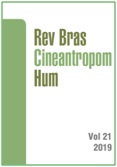What pacing strategy 800m and 1500m swimmers use?
DOI:
https://doi.org/10.1590/1980-0037.2019v21e59851Abstract
Pacing strategy (PS) has a decisive impact on performance, especially on long-term races. The objective of this study is to characterize the PS used in swimming races of 800m and 1500m freestyle by the finalists of the Olympic trials of the United States, Europe and Brazil, and the Olympic finalists of 2016. Time partials of 63 athletes were analyzed using a decision tree and the CHAID method. The results showed that parabolic was adopted by swimmers of 800m, they start in first lap (29.67 ± 0.88 s), followed by an increase in time (+1.77 s) and a subsequent increase in time (32.04 ± 0.89 s), at the end, the swimmers presented an acceleration, reducing the average of the to 31.44 s. And by the free 1500m swimmers, divided into blocks with a faster average start (29.25 ± 1.15 s), half of the slowest race (30.30 ± 0.76 s), and a new acceleration at the end of the event (29.92 ± 1.12 s), both in the selective Olympic Games and the 2016 and 2016 Olympic final. The worst partials times were observed in the Brazilian Selective (Test Event) (31.11 ± 0.78 s). Medalist, despite presetting the same OS, can sustain a better rhythm throughout he 800m (31.52 ± 1.03 s) and 1500-m (29.80 ± 0.78). We conclude that parabolic PS is the optimal strategy adopted by swimmers of 800-m and 1500m freestyle.
References
Gatti R, Erichsen O, Melo S. Respostas fisiológicas e biomecânicas de nadadores em diferentes intensidades de nado. Rev Bras Cineantropom Desempenho Hum 2004;6(1):26-35.
Barbosa TM, Keskinen KL, Vilas-Boas JP. Factores biomecânicos e bioenergéticoslimitativos do rendimento em natação pura desportiva. Motri 2007;2(4):201-213.
Pires G, Pelegrinotti I. Análise dos segmentos saída, viradas, e chegada em prova de 400m nado livre: comparação do desempenho de nadadoras paulistas e europeias. Col Pesq Educ Fís 2010;9(6):49-56.
De Souza Castro FA, Diefenthaeler F, Colpes F, Peterson Silva R, Franken M. Desempenho e pacing na prova de 200m nado borboleta: variabilidade erelações dos tempos parciais de 50m com o tempo final. Rev Andal Med Deporte 2017;10(4):197-201.
Saavedra JM, Escalante Y, Garcia-Hermoso A, Arellano R, Navarro FA. 12-year analysis of pacing strategies in 200- and 400-m individual medley in international swimming competitions. J Strength Cond Res 2012;26(12):3289-3296.
Damasceno M, Correia-Oliveira C, Narita T, Pasqua L, Bueno S, Lima-Silva A etal. Estratégia adotada em provas de natação estilo crawl: uma análise das distâncias de 800 e 1500m. Rev Bras Cineantropom Desempenho Hum 2013;15(3):361-370.
Carmo E, Barreti D, Ugrinowitsch C, Tricoli V. Pacing strategy in middle and long distance running: how are velocities adjusted during the race? Rev Bras Educ Fís Esporte 2012;26(2):351-363.
Garland S. An analysis of the pacing strategy adopted by elite competitors in 2000m rowing. Br J Sports Med 2005;39(1):39-42.
Fernandes AL, Bertuzzi R, Lima-Silva E. Estratégia de Prova: Mecanismo de regulação, influência dos fatores ambientais e circadianos. Rev Bras Educ Fís Esporte 2015;5(5):114-138.
Thompson KG, Haljand R, Maclaren DP. An analysis of selected kinematicvariables in national and elite male and female 100-m and 200-m breaststroke swimmers J Sports Sci 2000;18(6):421-31.
Mauger AR, Neuloh J, Castle PC. Analysis of pacing strategy selection in elite 400m freestyle swimming. Med Sci Sports Exerc 2012;44(11):2205–2212.
Thompson KG, Maclaren DP, Less A, Atkinson G. The effect of even, positive andnegative pacing on metabolic, kinematic and temporal variables during breaststrokeswimming. Eur J Appl Physiol 2003;88:438-43.
Lipińska P, Allen SV, Hopkins WG. Relationships between pacing parameters and performance of elite male 1500m swimmers. Int J Sports Physiol Perform 2016a;11(2):159-163.
Lipińska P, Allen SV, Hopkins, WG. Modeling parameters that characterize pacing of elite female 800m freestyle swimmers. Eur J Sport Sci 2016b;16(3):287-292.
Araujo CGS, Perez AJ, Matsudo VKR. Técnica para a análise da estratégia dos 1500m nado livre. Rev Bras Med Esporte 1980;1(3):35-43.
Deminice R, Papoti M, Zagatto AM, Prado Junior MV. Validade do teste de 30minutos (T-30) na determinação da capacidade aeróbia, parâmetros de braçada e performance aeróbia de nadadores treinados. Rev Bras Med Esporte 2007;13(3):195-199.
Noakes T, St Clair GA, Lambert E. From catastrophe to complexity: a novel model of integrative central neural regulation of effort and fatigue during exercise in humans: summary and conclusions. Br J Sports Med 2005;39(2):120-124.
Tucker R, Noakes TD. The physiological regulation of pacing strategy during exercise: a critical review. Br J Sports Med 2009;43(6):392-400.
Skorski S, Faude O, Abbiss C, Caviezel S, Wengert N, Meyer T. Influence of pacing manipulation on performance of juniors in simulated 400 m swim competition. Int J Sports Physiol Perform 2014;9(5):817-824.
Magidson J. The Chaid approach to segmentation modelling, In: Bagozzi RP, editor. Advanced methods of marketing research, Cambridge: Blackwell 1994, p. 118-159.
Muehlbauer T, Panzer S, Schindler C. Pacing pattern and speed skating performance in competitive long-distance events. J Strength Cond Res 2010;24(1):114-9.
Noakes TD, Lambert MI, Hauman R. Which lap is the slowest? An analysis of 32 world mile record performances. Br J Sports Med 2009;43(10):760-764.
Costa M.J, Marinho DA, Reis VM, Silva AJ, Marques MC, Bragada JA, etal. Tracking the performance of world-ranked swimmers. J Sports Sci Med 2010;9(3):411-417.
Robertson E, Pyne D, Hopkins WG, Anson J. Analysis of lap times in internationalswimming competitions. J Sports Sci 2009; 27(4): 387-395.
Ulmer HV. Concept of an extracellular regulation of muscular metabolic rateduring heavy exercise in humans by psychophysiological feedback. Experientia 1996;52(5):416-20.
Hanon C, Gajer B. Velocity and stride parameters of world-class 400-meter athletescompared with less experienced runners. J Strength Cond Res 2009;23(2):524-531.



